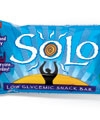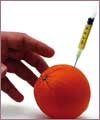Stephanie French MSc11.01.05
"Glycemic index is a revolutionary way of eating, as it does not proscribe or prescribe. It enables consumers to select from a range of daily foods commonly consumed by everyone. It is a way of eating that is going be beneficial for all of us."
-Jeya Henry, Professor of Human Nutrition at Oxford Brookes University, one of the leading centers in the U.K. for glycemic index (GI) testing
So what is glycemic index (GI) and what makes it so special? In simple terms it is a method for classifying carbohydrate-containing foods. Individual foods are assigned values according to how fast they are digested and absorbed into the bloodstream. Consumption of lower GI foods results in a reduction in blood glucose concentration, which in turn leads to a reduction in insulin secretion.
Low GI foods appear to play multiple roles in energy regulation, insulin response and lipid metabolism. However, one of its key roles is in blood sugar regulation-hence in diabetes management.
Diabetes is fundamentally a condition of disordered glucose metabolism, so it seems logical that the type of dietary carbohydrates consumed could influence the risk and course of the disease. There is good support from large cohort studies such as the Nurses' Health Study (over 60,000 women) and the Health Professional's Follow-Up Study (over 50,000 men) for the role of high GI diets in increasing the risk of adult-onset, or type 2 diabetes (Salmeron et al 1997, JAMA; 1999, Diabetes Care). As well as reducing the risk of developing diabetes, low GI diets have an important role to play in the management of diets of those already diabetic. In particular, the consumption of slowly digested carbohydrates produces lower peaks in blood glucose and is therefore advantageous in maintaining glycemic control (Brand-Miller et al 2003, Diabetes Care).
It seems relatively clear that GI has a role to play in the management of diabetes, but can it offer any solutions to the obesity crisis which we are currently facing, given that obesity is frequently a precursor to the onset of diabetes itself?
There have been several clinical trials carried out in humans in which energy restricted diets based on low GI foods produced greater weight loss than did equivalent diets based on high GI foods. However, this evidence comes mainly from short-term feeding studies and, moreover, some studies failed to match the macronutrient content of test meals, thus not taking into account factors like fiber content or energy density, which might also influence bodyweight.
While the physiological mechanisms indicate that low GI foods should provide more sustained energy than higher GI alternatives due to their slower release of blood sugars, the studies which have looked at the effect of GI on hunger and food intake at subsequent meals have produced mixed results. The most likely reason for this is that a majority of consumers no longer listen to satiety signals. There are a range of reasons why people eat, including social and psychological influences, as well as hunger, but in reality it is probably only those focused on reducing their weight that place strong emphasis on satiety signals.
Julian Stowell, science director, Danisco Sweeteners, and chair of the Calorie Control Council, believes GI is one tool in the battle against obesity. "We should not promote GI or indeed GL [glycemic load] as the only answer to obesity, but it is one additional parameter which will aid consumers in making an informed choice," he said. Mr. Stowell goes on to reiterate that "calories still count since the energy balance of 'calories in' versus 'calories out' will always hold, but if by moving to lower glycemic carbohydrates we can feel fuller for longer, the net result should be a lower consumption of calories."
Nevertheless, further research on GI and energy regulation is required with an emphasis on long-term, well designed studies to generate some more concrete data on the possible treatment of obesity with low GI diets. Indeed, critics of the GI rating of foods claim that there are inherent weaknesses in the system due to its over simplification of the situation. They frequently reference examples of foods that have high GI values but are naturally healthy, such as watermelon (GI 72) and carrots (GI 90), while pointing out that foods like ice cream can be re-formulated to be low GI but clearly do not present healthy dietary choices due to their high fat content.
These critics often support the use of glycemic load (GL) ratings of foods. GL takes into account not just the GI rating of a food, but also the quantity of carbohydrate contained therein. For instance,a 100-gram serving of watermelon has a high GI of 72, but a GL of only 3 grams. In contrast, a 100-gram serving of spaghetti has a low GI of 38 but a much higher GL of 9 grams. GL as a measure is therefore a means to represent both the quality and quantity of carbohydrate in a food, and can provide an indication of the total glycemic effect of consumption.
While for weight management the concept of GL may be of greater value than GI, presenting an alternative to calorie counting as it does, it is probably too confusing for most consumers who are merely keen to make healthier selections for their diets. Glycemic Index (GI) Ltd, the company formed between the University of Sydney, Diabetes Australia and the Juvenile Diabetes Research Foundation to implement the GI Symbol Program in Australia, goes even further. Their position is best explained in a recent letter to the editor of Diabetes Care, which they fully endorse (Barclay et al 2005). While the effects on postprandial glycemia may be essentially the same, there is evidence that the two approaches will have very different metabolic effects on insulin sensitivity, triglyceride concentrations and free fatty acids. GI Ltd. questions whether a low GL/high GI/low carbohydrate diet would have the same protective effect on prevention of type 2 diabetes as has been demonstrated for a low GI/high fiber/moderate to high carbohydrate diet.
In Professor Henry's opinion, there may be a useful role for GL in pre-packed food items of defined portion sizes, but since few people's diets comprise such items in isolation, total dietary management using GL is likely to remain a distant goal. In any case, further work is required to understand the GL cut-off points (i.e., what should be classified as low, medium and high) and more importantly still, what an ideal total daily intake of GLs should be.
It is not possible to ascribe a GI rating to a product by in vitro laboratory testing and the following outline of the procedure involved will serve to explain why testing costs can run into the thousands of dollars per product. Note that this is an example procedure only and exact details may vary according to the individual testing body used.
In a typical test, approximately a dozen subjects provide blood samples after overnight fasts. They then consume 50 grams of glucose and six further blood samples are taken at 15 minutes intervals. This procedure is then completed three times on each subject on separate days, generally with an interval of at least one day between tests. Once the baseline tests have been completed, subjects consume a portion of the test product containing 50 grams of available carbohydrate and blood samples are taken under the same procedure as with the pure glucose to analyze how quickly the carbohydrates are broken down into glucose in the blood.
Products with a GI rating of less than 55 are then classified as low GI foods, those with a rating of more than 70 are classified as high, and those falling in between the two are medium.
What about regulatory barriers? The FDA does allow food companies to use "glycemic index" statements on food labels, as long as their GI values are determined by clinical testing. In Canada, however, the situation is much more restrictive: "In the absence of a defined method for determining the glycemic index of each food", statements such as "low glycemic index" and "glycemic index = 10" are not permitted, nor are claims such as "rapid absorption" or "does not raise blood sugar."
Use of GI Labeling Becoming More Popular
In the U.S., the GI concept is still in its early stages of development. The Glycemic Index Research Institute, Washington, D.C., is currently the only body in the country authorized to carry out in vivo clinical testing of products for their GI values.
U.S. Mills Uncle Sam cereal was one of the first to carry a GI rating but other products now include ready meals manufacturer Savvy Faire Lifestyle Cuisine, the Solo GI Nutrition bar, Fifty50 Foods peanut butter and cookies and Russell Stover DiabetX, low GI sugar-free confectionery. The latter two ranges are overtly targeted to diabetics. In fact, it is a general tendency in the U.S. market for low GI rated products to be marketed primarily on a low carbohydrate or diabetic platform. Most mainstream brands have yet to wave the GI banner. However, in June 2005, Mars launched Snickers Marathon Energy Bar Fortified for Women in three varieties, all of which have been GI tested, with their low GI message being communicated via marketing materials.
Europe has moved at a faster pace on the GI labeling front. In the U.K., leading retailer Tesco is looking to have more than 1000 products tested and labeled before the end of 2005 and Warburton's developed its All-In-One bread to have a lower GI than standard white breads and a claim to give the consumer "longer lasting energy." Yogurts, beverages and prepared meals are also increasingly being branded with GI ratings in the U.K.
In Finland, the largest dairy company, Valio, added low GI to the list of health benefits it claims for its A+ brand of yogurt, stating on the package that it "levels blood sugar after a meal." Valio achieved GI values of between 19 and 27 for the range through a combination of added fiber and the use of fructose, a low GI sweetener.
Australia is perhaps the market with the widest range of GI-rated foods, which is hardly surprising given that it has been at the forefront of research in this area for several years. The Gly�cemic Index Symbol Program (GISP) was launched in 2002. In order to carry the low GI logo, products must meet certain criteria for nutritional composition related to total fat, sodium, dietary fiber, calcium and energy levels, for example, as well as containing a minimum 10 grams of carbohydrates per serving and, of course, a GI rating of less than 55.
Products carrying low GI ratings include juices, ice cream, caramel chews, fromage frais and yogurts. Gareth Hughes, business manager, GI Ltd., said "We are keen to expand the program globally to ensure an accurate and balanced view of GI. Our nutrition criteria are very important factors in developing credibility amongst health professionals to ensure that GI is not used as a gimmick to sell what most would perceive as being unhealthy choices." He also indicated that the company is talking to like-minded organizations in the U.S. and Canada, with a purpose of establishing strategic alliances to achieve these [and other] aims."
Simple formulation changes to lower GI ratings of foods could include adding kernels or incorporating coarse flour into bread, adding more protein (e.g., meat, dairy or soy) or selecting unprocessed cereal such as brown rice. Slightly more complex approaches would include the enrichment of foods with viscous fiber (e.g., beta-glucans) or using polyols (e.g., sorbitol). Modifying the manufacturing process can also affect the GI rating, as the degree of starch gelatinization, the particle size, the food matrix and the cellular structure are all relevant factors.
Resistant starch, such as Hi-Maize, which is manufactured by National Starch, is being used increasingly in low GI product formulations as is inulin, which acts as a bulking agent and therefore works well in sugar and starch replacement. Inulin offers the additional advantage of being a prebiotic fiber.
According to Danisco's Julian Stowell, polydextrose has experienced particular success recently within the specialty carbohydrate area. Polydextrose can replace the sugar and starch in a food, with intense sweetener(s) being added if necessary in the case of sweet goods. "Since around 13% of our calories currently come from sweet baked goods and confectionery, and this situation is unlikely to change in the near future, polydextrose offers one easy way to make those products healthier and to reduce their glycemic impact" he said.
So for those manufacturers not already involved with the glycemic index, where does all this leave us? As far as obesity is concerned, for those consumers whose primary difficulty with weight loss diets is feeling hungry, low GI diets may offer satiety benefits, as well as encouraging more balanced diets. In fact, even if GI values themselves are not publicized, the concept of sustained energy, which derives from the consumption of lower GI foods, looks certain to be touted increasingly on a range of processed foods-and is thus likely to become a key dietary concept in the minds of consumers over the next year or two.
But unfortunately when it comes to the problem of obesity and weight loss, people no longer eat just because they are hungry and over indulgence has become a way of life for many. One obvious opportunity is to target those motivated to live a healthier lifestyle, but not necessarily through weight loss alone. Perhaps a more interesting target is those people motivated neither to modify their diet nor to change their lifestyle-for these people, improved formulations of processed foods through addition of fibers or replacement of sugar with low GI sweeteners could improve their diets with little conscious effort.
Research from several countries indicates that healthy eating education frequently fails in its aims and thus modification of foods that people like to eat is perhaps a more effective, and indeed more responsible way for the food industry to improve the health of consumers. Nevertheless, the food industry will not do itself any favors if it manipulates GI ratings in such a way as to cause negative health repercussions, for example, by increasing fat content. It is important to develop formulations, which lead to an overall improvement in well being.
There is unfortunately no single proven magic bullet for solving the problem of obesity. While GI is an important indicator of healthy foods, in the short term the incorporation of yet another factor into the balanced diet equation risks confusing the consumer. However, if computerized methods of dietary management become more established, manufacturers unable to provide information on GI may find themselves losing out. Technology has already been developed in Finland to permit mobile phones to compare the nutritional quality of foods on the supermarket shelf and more sophisticated and widespread techniques are probably not far away.NW
About the author: Stephanie French is director of Harlequin Plus Ltd., a U.K.-based consultancy specializing in nutrition strategy and marketing and related new product development. She can be reached at stephanie.french@harlequinplus.com; Website: www.harlequinplus.com.
-Jeya Henry, Professor of Human Nutrition at Oxford Brookes University, one of the leading centers in the U.K. for glycemic index (GI) testing
So what is glycemic index (GI) and what makes it so special? In simple terms it is a method for classifying carbohydrate-containing foods. Individual foods are assigned values according to how fast they are digested and absorbed into the bloodstream. Consumption of lower GI foods results in a reduction in blood glucose concentration, which in turn leads to a reduction in insulin secretion.
Low GI foods appear to play multiple roles in energy regulation, insulin response and lipid metabolism. However, one of its key roles is in blood sugar regulation-hence in diabetes management.
Diabetes is fundamentally a condition of disordered glucose metabolism, so it seems logical that the type of dietary carbohydrates consumed could influence the risk and course of the disease. There is good support from large cohort studies such as the Nurses' Health Study (over 60,000 women) and the Health Professional's Follow-Up Study (over 50,000 men) for the role of high GI diets in increasing the risk of adult-onset, or type 2 diabetes (Salmeron et al 1997, JAMA; 1999, Diabetes Care). As well as reducing the risk of developing diabetes, low GI diets have an important role to play in the management of diets of those already diabetic. In particular, the consumption of slowly digested carbohydrates produces lower peaks in blood glucose and is therefore advantageous in maintaining glycemic control (Brand-Miller et al 2003, Diabetes Care).
Can Low GI Diets Reduce Obesity?
It seems relatively clear that GI has a role to play in the management of diabetes, but can it offer any solutions to the obesity crisis which we are currently facing, given that obesity is frequently a precursor to the onset of diabetes itself?
There have been several clinical trials carried out in humans in which energy restricted diets based on low GI foods produced greater weight loss than did equivalent diets based on high GI foods. However, this evidence comes mainly from short-term feeding studies and, moreover, some studies failed to match the macronutrient content of test meals, thus not taking into account factors like fiber content or energy density, which might also influence bodyweight.
While the physiological mechanisms indicate that low GI foods should provide more sustained energy than higher GI alternatives due to their slower release of blood sugars, the studies which have looked at the effect of GI on hunger and food intake at subsequent meals have produced mixed results. The most likely reason for this is that a majority of consumers no longer listen to satiety signals. There are a range of reasons why people eat, including social and psychological influences, as well as hunger, but in reality it is probably only those focused on reducing their weight that place strong emphasis on satiety signals.
Julian Stowell, science director, Danisco Sweeteners, and chair of the Calorie Control Council, believes GI is one tool in the battle against obesity. "We should not promote GI or indeed GL [glycemic load] as the only answer to obesity, but it is one additional parameter which will aid consumers in making an informed choice," he said. Mr. Stowell goes on to reiterate that "calories still count since the energy balance of 'calories in' versus 'calories out' will always hold, but if by moving to lower glycemic carbohydrates we can feel fuller for longer, the net result should be a lower consumption of calories."
Nevertheless, further research on GI and energy regulation is required with an emphasis on long-term, well designed studies to generate some more concrete data on the possible treatment of obesity with low GI diets. Indeed, critics of the GI rating of foods claim that there are inherent weaknesses in the system due to its over simplification of the situation. They frequently reference examples of foods that have high GI values but are naturally healthy, such as watermelon (GI 72) and carrots (GI 90), while pointing out that foods like ice cream can be re-formulated to be low GI but clearly do not present healthy dietary choices due to their high fat content.
These critics often support the use of glycemic load (GL) ratings of foods. GL takes into account not just the GI rating of a food, but also the quantity of carbohydrate contained therein. For instance,a 100-gram serving of watermelon has a high GI of 72, but a GL of only 3 grams. In contrast, a 100-gram serving of spaghetti has a low GI of 38 but a much higher GL of 9 grams. GL as a measure is therefore a means to represent both the quality and quantity of carbohydrate in a food, and can provide an indication of the total glycemic effect of consumption.
While for weight management the concept of GL may be of greater value than GI, presenting an alternative to calorie counting as it does, it is probably too confusing for most consumers who are merely keen to make healthier selections for their diets. Glycemic Index (GI) Ltd, the company formed between the University of Sydney, Diabetes Australia and the Juvenile Diabetes Research Foundation to implement the GI Symbol Program in Australia, goes even further. Their position is best explained in a recent letter to the editor of Diabetes Care, which they fully endorse (Barclay et al 2005). While the effects on postprandial glycemia may be essentially the same, there is evidence that the two approaches will have very different metabolic effects on insulin sensitivity, triglyceride concentrations and free fatty acids. GI Ltd. questions whether a low GL/high GI/low carbohydrate diet would have the same protective effect on prevention of type 2 diabetes as has been demonstrated for a low GI/high fiber/moderate to high carbohydrate diet.
In Professor Henry's opinion, there may be a useful role for GL in pre-packed food items of defined portion sizes, but since few people's diets comprise such items in isolation, total dietary management using GL is likely to remain a distant goal. In any case, further work is required to understand the GL cut-off points (i.e., what should be classified as low, medium and high) and more importantly still, what an ideal total daily intake of GLs should be.
Obtaining GI ratings
It is not possible to ascribe a GI rating to a product by in vitro laboratory testing and the following outline of the procedure involved will serve to explain why testing costs can run into the thousands of dollars per product. Note that this is an example procedure only and exact details may vary according to the individual testing body used.
In a typical test, approximately a dozen subjects provide blood samples after overnight fasts. They then consume 50 grams of glucose and six further blood samples are taken at 15 minutes intervals. This procedure is then completed three times on each subject on separate days, generally with an interval of at least one day between tests. Once the baseline tests have been completed, subjects consume a portion of the test product containing 50 grams of available carbohydrate and blood samples are taken under the same procedure as with the pure glucose to analyze how quickly the carbohydrates are broken down into glucose in the blood.
Products with a GI rating of less than 55 are then classified as low GI foods, those with a rating of more than 70 are classified as high, and those falling in between the two are medium.
What about regulatory barriers? The FDA does allow food companies to use "glycemic index" statements on food labels, as long as their GI values are determined by clinical testing. In Canada, however, the situation is much more restrictive: "In the absence of a defined method for determining the glycemic index of each food", statements such as "low glycemic index" and "glycemic index = 10" are not permitted, nor are claims such as "rapid absorption" or "does not raise blood sugar."
Use of GI Labeling Becoming More Popular
In the U.S., the GI concept is still in its early stages of development. The Glycemic Index Research Institute, Washington, D.C., is currently the only body in the country authorized to carry out in vivo clinical testing of products for their GI values.
U.S. Mills Uncle Sam cereal was one of the first to carry a GI rating but other products now include ready meals manufacturer Savvy Faire Lifestyle Cuisine, the Solo GI Nutrition bar, Fifty50 Foods peanut butter and cookies and Russell Stover DiabetX, low GI sugar-free confectionery. The latter two ranges are overtly targeted to diabetics. In fact, it is a general tendency in the U.S. market for low GI rated products to be marketed primarily on a low carbohydrate or diabetic platform. Most mainstream brands have yet to wave the GI banner. However, in June 2005, Mars launched Snickers Marathon Energy Bar Fortified for Women in three varieties, all of which have been GI tested, with their low GI message being communicated via marketing materials.
Europe has moved at a faster pace on the GI labeling front. In the U.K., leading retailer Tesco is looking to have more than 1000 products tested and labeled before the end of 2005 and Warburton's developed its All-In-One bread to have a lower GI than standard white breads and a claim to give the consumer "longer lasting energy." Yogurts, beverages and prepared meals are also increasingly being branded with GI ratings in the U.K.
In Finland, the largest dairy company, Valio, added low GI to the list of health benefits it claims for its A+ brand of yogurt, stating on the package that it "levels blood sugar after a meal." Valio achieved GI values of between 19 and 27 for the range through a combination of added fiber and the use of fructose, a low GI sweetener.
Australia is perhaps the market with the widest range of GI-rated foods, which is hardly surprising given that it has been at the forefront of research in this area for several years. The Gly�cemic Index Symbol Program (GISP) was launched in 2002. In order to carry the low GI logo, products must meet certain criteria for nutritional composition related to total fat, sodium, dietary fiber, calcium and energy levels, for example, as well as containing a minimum 10 grams of carbohydrates per serving and, of course, a GI rating of less than 55.
Products carrying low GI ratings include juices, ice cream, caramel chews, fromage frais and yogurts. Gareth Hughes, business manager, GI Ltd., said "We are keen to expand the program globally to ensure an accurate and balanced view of GI. Our nutrition criteria are very important factors in developing credibility amongst health professionals to ensure that GI is not used as a gimmick to sell what most would perceive as being unhealthy choices." He also indicated that the company is talking to like-minded organizations in the U.S. and Canada, with a purpose of establishing strategic alliances to achieve these [and other] aims."
Formulation Techniques
Simple formulation changes to lower GI ratings of foods could include adding kernels or incorporating coarse flour into bread, adding more protein (e.g., meat, dairy or soy) or selecting unprocessed cereal such as brown rice. Slightly more complex approaches would include the enrichment of foods with viscous fiber (e.g., beta-glucans) or using polyols (e.g., sorbitol). Modifying the manufacturing process can also affect the GI rating, as the degree of starch gelatinization, the particle size, the food matrix and the cellular structure are all relevant factors.
Resistant starch, such as Hi-Maize, which is manufactured by National Starch, is being used increasingly in low GI product formulations as is inulin, which acts as a bulking agent and therefore works well in sugar and starch replacement. Inulin offers the additional advantage of being a prebiotic fiber.
According to Danisco's Julian Stowell, polydextrose has experienced particular success recently within the specialty carbohydrate area. Polydextrose can replace the sugar and starch in a food, with intense sweetener(s) being added if necessary in the case of sweet goods. "Since around 13% of our calories currently come from sweet baked goods and confectionery, and this situation is unlikely to change in the near future, polydextrose offers one easy way to make those products healthier and to reduce their glycemic impact" he said.
GI Represents the Future of Nutrition Labeling
So for those manufacturers not already involved with the glycemic index, where does all this leave us? As far as obesity is concerned, for those consumers whose primary difficulty with weight loss diets is feeling hungry, low GI diets may offer satiety benefits, as well as encouraging more balanced diets. In fact, even if GI values themselves are not publicized, the concept of sustained energy, which derives from the consumption of lower GI foods, looks certain to be touted increasingly on a range of processed foods-and is thus likely to become a key dietary concept in the minds of consumers over the next year or two.
But unfortunately when it comes to the problem of obesity and weight loss, people no longer eat just because they are hungry and over indulgence has become a way of life for many. One obvious opportunity is to target those motivated to live a healthier lifestyle, but not necessarily through weight loss alone. Perhaps a more interesting target is those people motivated neither to modify their diet nor to change their lifestyle-for these people, improved formulations of processed foods through addition of fibers or replacement of sugar with low GI sweeteners could improve their diets with little conscious effort.
Research from several countries indicates that healthy eating education frequently fails in its aims and thus modification of foods that people like to eat is perhaps a more effective, and indeed more responsible way for the food industry to improve the health of consumers. Nevertheless, the food industry will not do itself any favors if it manipulates GI ratings in such a way as to cause negative health repercussions, for example, by increasing fat content. It is important to develop formulations, which lead to an overall improvement in well being.
There is unfortunately no single proven magic bullet for solving the problem of obesity. While GI is an important indicator of healthy foods, in the short term the incorporation of yet another factor into the balanced diet equation risks confusing the consumer. However, if computerized methods of dietary management become more established, manufacturers unable to provide information on GI may find themselves losing out. Technology has already been developed in Finland to permit mobile phones to compare the nutritional quality of foods on the supermarket shelf and more sophisticated and widespread techniques are probably not far away.NW
About the author: Stephanie French is director of Harlequin Plus Ltd., a U.K.-based consultancy specializing in nutrition strategy and marketing and related new product development. She can be reached at stephanie.french@harlequinplus.com; Website: www.harlequinplus.com.





















